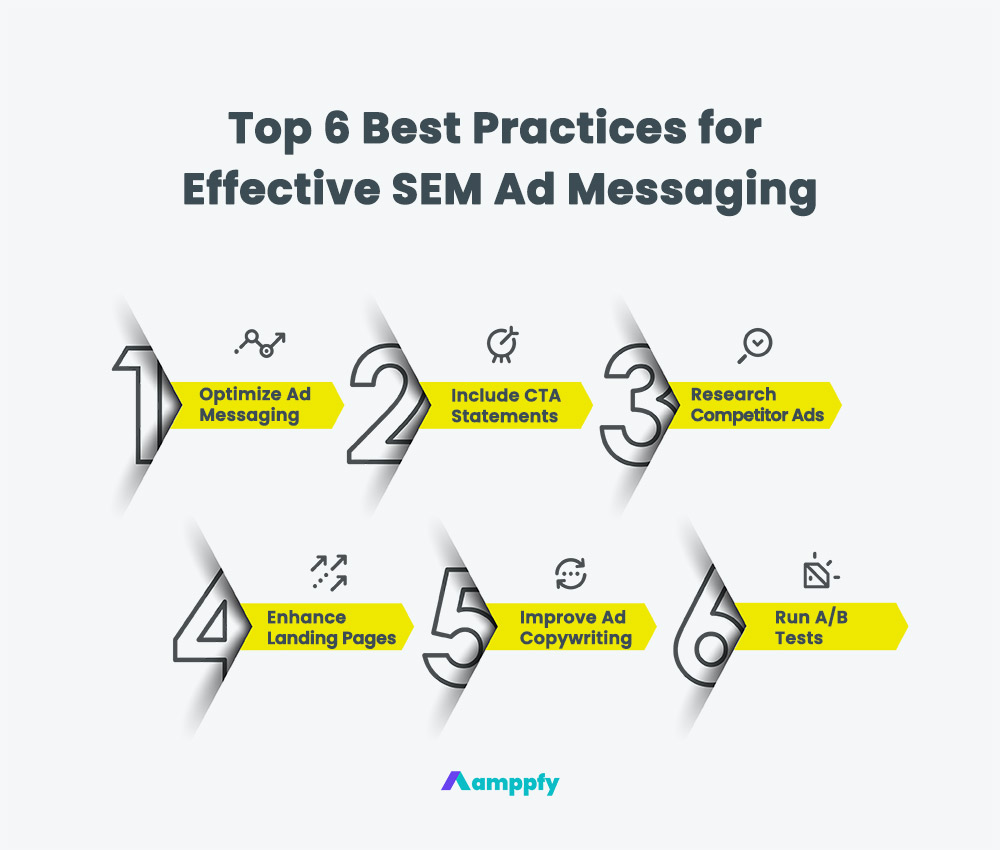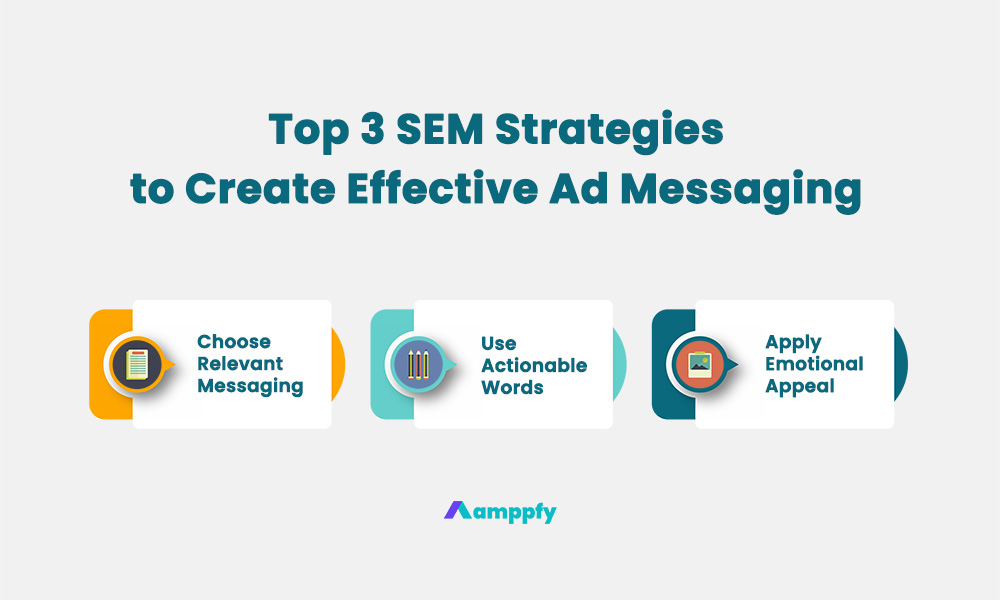Two essential components of a successful SEM marketing campaign are the messaging in the ad copy and the content on the landing page. Compelling ad messaging and relevant call-to-action content drive SEM campaign engagement, improve CTR (Click-Through Rate) and increase the conversion rate of a sale. Here are the top SEM ad messaging best practices to create high-converting SEM ad campaigns.
Top 6 Best Practices for Creating Effective SEM Ads and Campaign Messaging

#1: Optimize Messaging in SEM Ads
Ad content and messaging are integral to SEM ad campaigns. In Google Ads and Microsoft Ads, you are only given a certain amount of text for three headline titles and two lines of description text. So every word counts.
Google Ads Character Count Limits
- Headline 1: 30 characters
- Headline 2: 30 characters
- Headline 3: 30 characters
- Description line 1: 90 characters
- Description line 2: 90 characters
Word Choice Matters in SEM Ad Messaging
The max character count limits the messaging options quite significantly. So, word choice becomes the critical success factor determining an ad campaign’s ability to engage potential leads and capture conversion. Solid SEM marketing strategy consistently tests the messaging of an ad and tries to achieve the best click-through rate.
Top 3 Strategies to Create Effective Messaging for SEM Ads

Strategy #1. Choose Relevant and Concise Words in SEM Ads
Choose relevant and concise words that are simple and easy to understand. Avoid overuse of jargon or abbreviations that could cause confusion.
Strategy#2. Use Actionable Words in SEM Ads
Use actionable words such as “buy now,” “sign up today,” and “download now” to encourage visitors to take a specific action while viewing the ad.
Strategy#3. Apply Emotional Appeal in SEM Ads
Apply emotional appeal that resonates with core audience sentiments. Base the ad campaign strategy on your ideal customer profile’s past behaviors, interactions, and preferences.
#2: Improve SEM Ad Messaging with Call-to-Action Statements
Create call-to-action ad messaging by identifying the core audience’s needs, wants, and pain points. Align the ad messaging to fulfill a demand or solve a common problem. Plan the ad campaigns by focusing on value-added benefit statements and call-to-actions that incentivize visitors to click through on an ad.
Here are examples of ad messaging with effective call-to-action statements.
3 Examples of SEM Ad Messaging Call-to-action Statements
- Sign up today and receive a free consultation.
- Sign up now to start your 30-day free trial.
- Join today and receive a complimentary gift.
#3: Research Competitor SEM Ads and Campaign Content
Differentiating your ad messaging from competitors saves marketing dollars by avoiding unnecessary price wars. Search a relevant keyword about your business on Google, and check out how your competitors run their SEM ad campaigns.
How to Research Competitor SEM Ads and Campaign Content
Use SEM tools like Semrush to uncover competitors’ ad content and recent SEM campaigns. Understanding competitor campaign strategies help you better identify your own unique advantages. Keep them in mind when creating ad content and messaging.
#4: Enhance Campaign Landing Pages in SEM Ads
Pay attention to the SEM ad campaign landing page’s formatting and layout. Make sure it looks good on different devices like desktop, tablet, and mobile. The ad campaign could influence a prospect’s first impression of your business online. Plan the ad campaign landing page with a balance of text and visuals. Avoid overcrowding the page with an overwhelming amount of content. Follow Google Ads Policies to make your ad campaign stand out in a good way.
#5 Improve Campaign Copywriting in SEM Ads
Top 3 Strategies to Improve SEM Ad Campaign Copywriting
Strategy #1. Proofread the SEM Ad Copy
In addition to checking the spelling and grammar of an ad copy, avoid unnecessary symbols or inconsistent capitalization. Use free tools like Grammarly to proofread ad copies.
Strategy #2. Images Matter in SEM Display Ad Campaigns
If you run display ads through Google Ads, images are the selling points in the display ad campaign. Visuals can be eye-catching, quirky, or thought-provoking to improve visitor click-through rate. Use tools like Adobe Photoshop to create compelling visuals.
Strategy #3. Include Visual Separation in SEM Display Ad Campaigns
Consider leaving appropriate visual separation when creating Google display ads. Visual separation, such as proper spacing, brings more focus to the main content in the ad copy.
#6: Run A/B Testing on SEM Ad Campaign Messaging
Running an SEM ad campaign can get expensive. PPC (Pay-Per-Click) racks up to a significant amount and can quickly burn through the marketing budget. It is crucial to check and test your ad campaigns regularly and make sure you are not overspending or losing out on potential conversions.
A/B Testing SEM Ad Messaging Reduces Campaign Cost and Increases Conversion Rate
A/B testing is a great way to identify the best SEM ad campaign strategy and test ad messaging for effectiveness. You can test one element or keyword at a time and narrow down which ad messaging or landing page content works best to convert a lead or a sale. Periodically test ad campaign elements until you find the version that generates the highest conversion.
Learn more about the best strategies to reduce SEM campaign cost and increase conversion rate.
Top 3 SEM Ad Messaging Categories to A/B Test for Better Click Through Rate
SEM Ad Messaging Category #1. Absolute Statement
- 100% money back guaranteed
- Guaranteed results in 30 days or full refund
- Voted #1 nationwide
- Buy one get one free
SEM Ad Messaging Category #2. Comparative Statement
- Bigger savings
- Better results in 10 days
- Faster shipping
- Easier application
SEM Ad Messaging Category #3. Statistical Statement
- 20% off
- 33% more
- 4x faster
- 24/7 availability

